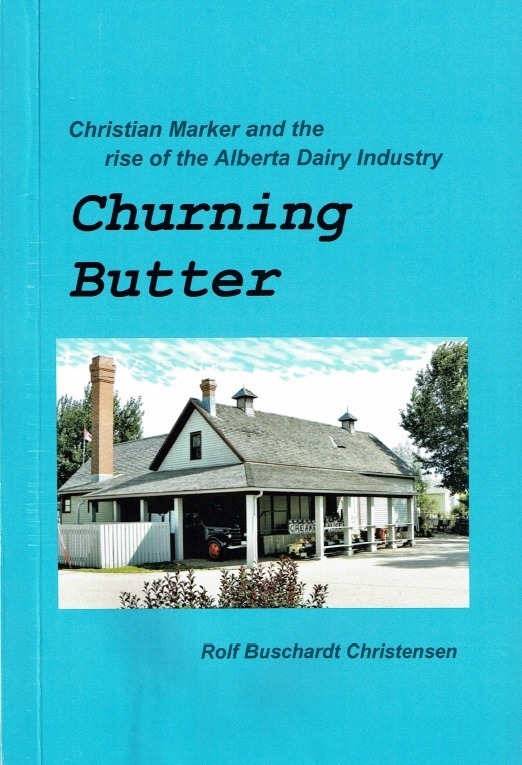BOOK REVIEW
Churning Butter - Christian Marker and the Rise of the Alberta Dairy Industry
Reviewed by Dr. Kurt F. Jensen, Adjunct Professor, Carleton University
To buy this book, click here.
Christian Marker was Alberta’s first dairy commissioner. A Danish immigrant from a small-farm background but with a solid education in the Danish dairy industry, he had come to Canada to start a new life. He was a man eager to expand his knowledge, with a strong intellectual bent and a determination to succeed.
Rolf Christensen has put together a book much more exciting and entertaining than a cursory glance at a book about dairy production might suggest. Marker, the son of a hero from the Dano-Prussian War, recognized that the opportunities in Denmark as a small landowner were narrow. He was ambitious – and clever. He immigrated to Canada in 1890 with little money and no knowledge of English. He initially worked as a dairy man in Ontario with his priority being to learn English. That job lasted nine months during which time he met Dominion Dairy Commissioner James Robertson, who visited the dairy where Marker was working and was so impressed that he offered Marker a job at the Central Experimental Farm in Ottawa.
There were many challenges to making the Canadian dairy industry viable. Great discrepancies existed in the quality of milk being produced, refrigeration was in its infancy, pasteurization had not yet been introduced, and machines to separate the milk and cream were just coming on stream. Marker had a good background in these areas, studied and researched constantly, and followed the Danish dairy industry closely since it was at the zenith of the new procedures and machinery being introduced.
Creameries of varying quality and success already existed in Canada and were beginning to become prevalent in Alberta, still part of the Northwest Territories at the time, where other Danes had been instrumental in introducing improved procedures and means of assessing the quality of the products. Financing of creameries were the major challenges to establishing a successful industry. Co-ops became a favoured vehicle, perhaps because they had worked well in Denmark, and the key leaders of the industry in the West were often Danish immigrants. The key to success proved to be the Dominion government which offered financing to co-ops on favourable terms, while often also assuming management of the operations.
Marker arrived in Calgary in 1897 to manage the government-operated creameries. Following creation of the Alberta province in 1905, Marker went from being Superintendent of Government Creameries to becoming the first Dairy Commissioner of Alberta, a position he retained for the remainder of his career, which eventually included being, concurrently, a Professor of Agriculture at the University of Alberta (eventually receiving an honourary Ph.D.). He was appointed the Honourary Danish Vice-Consul in Calgary until his move to Edmonton in 1921.
He was one of the key persons in the Western dairy industry, developing methods of enhancing the quality of the product. Education and training were the critical elements on the path to success, and a slow but steady implementations of improvement measures proved critical to advancement.
While a biography of Marker, this book in not just about him. The success of the Alberta dairy industry owes a lot to Marker but he was aided by many others of near similar enthusiasm and capabilities. Many of them were Danish immigrants, or other Scandinavians, as well as Anglo-Canadians. The large number of Danes involved in the industry simply reflected that Denmark was where the critical industrial advances originated.
The book contains many chapters providing brief histories of these other critical players in the dairy industry.
More important perhaps is the fact that this book is an important social history of one sector of Alberta’s development from the late 1800s to about the 1940s. It captures the dynamics of social, economic, and political progress of Alberta and, sometimes, the other prairie provinces.
Christensen’s book is an important contribution to documenting the history of Danes in Canada as well as capturing a sense of the social history of the West at a critical time. Especially, the book paints a colourful picture of those engaged in the dairy industry, the hardships and times of penury, and the founding of communities whose inhabitants worked together for the betterment of all. This is a book well worth reading.
Rolf Buschardt Christensen, Churning Butter: Christian Marker and the Rise of the Alberta Dairy Industry. Federation of Danish Associations in Canada, 2025. Pp. viii, 342. ISBN 978-1-988266-13-8.
Input your search keywords and press Enter.
